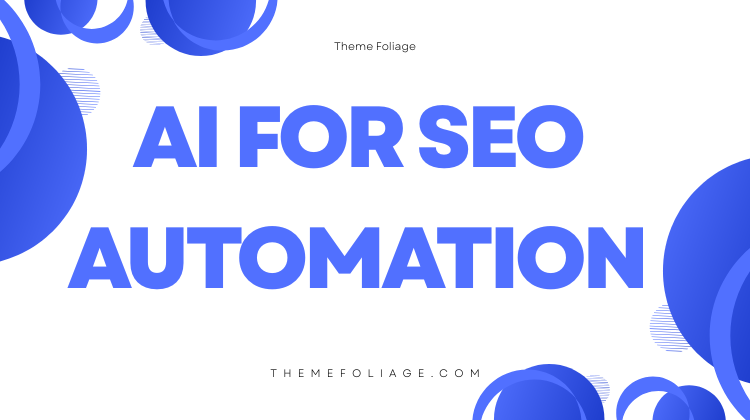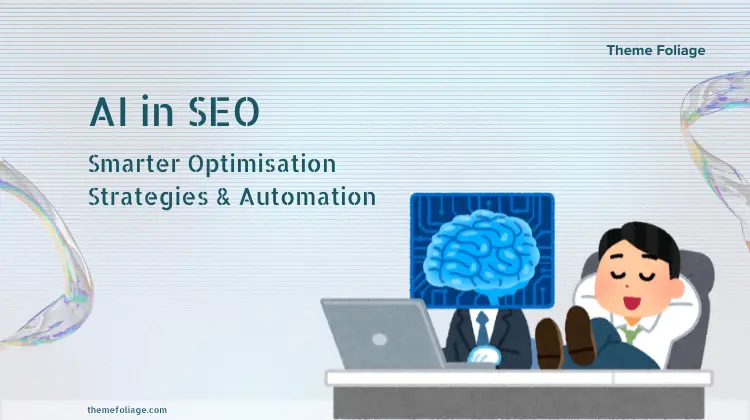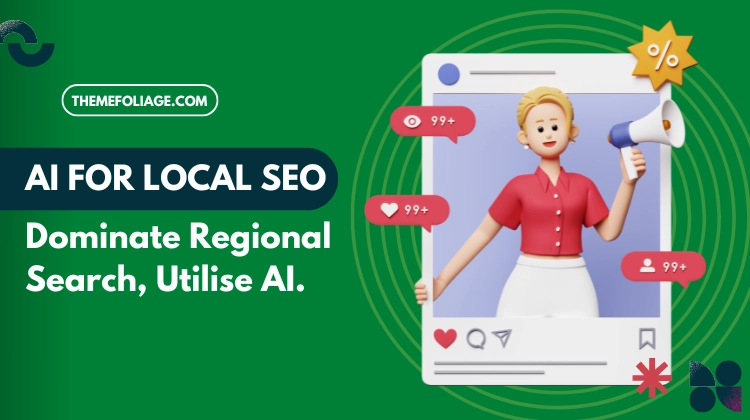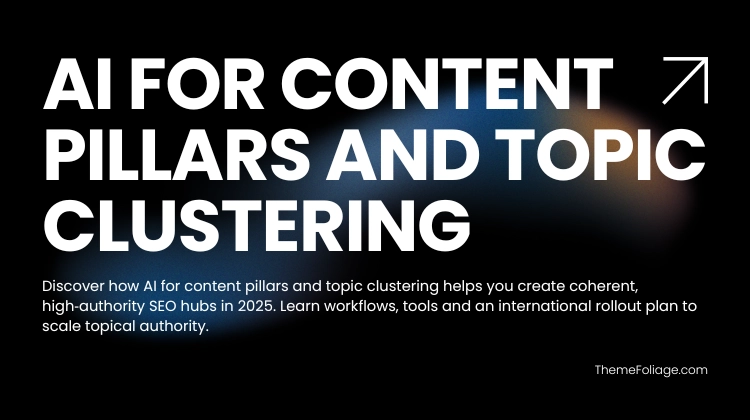AI for SEO Automation is reshaping how teams plan, produce and optimise content for search. Where manual processes once constrained scale, AI-driven automation allows marketing teams to generate data-led briefs, prioritise technical fixes and run iterative tests at speed.
Implemented correctly, AI for SEO Automation increases throughput, reduces repetitive labour and provides clearer signals for strategic decision-making.
This article explains what to automate first, how to architect practical systems, which tools to consider and how to measure return on investment.
Why AI for SEO Automation matters
Organisations attempting to own more topical real estate face two core problems: scale and consistency. Producing high-quality, search-optimised content across numerous categories consumes human hours and often introduces variance in editorial quality.
AI for SEO Automation addresses these problems by standardising routine tasks, keyword clustering, meta tag generation, content briefs and technical audits, while preserving human judgement for creative and strategic work.
Beyond operational efficiency, automation also improves speed to insight. Machine learning models and rule-based systems can surface non-obvious correlations between user intent, page performance and technical issues.
Teams that adopt AI-driven prioritisation often make better trade-offs about where to allocate scarce engineering and editorial resources.
Core use cases: what to automate first
Prioritise automation where the expected impact is high and the risk to brand or user experience is low. Typical starting points are:
- Keyword research and clustering: Use AI to expand seed terms into large sets of long-tail permutations, then cluster by intent and semantic similarity. This produces targetable groups for content and internal linking plans.
- Content briefs: Generate structured outlines that include H2 suggestions, target keywords, suggested word counts and internal linking targets. These briefs reduce writer onboarding time and increase topical relevance.
- Meta tags and schema suggestions: Automate title and meta description variants and produce templated schema (Article, Product, FAQ) that reduces markup errors.
- Technical audits and ticketing: Schedule automated crawls and log analyses to detect drops in crawl frequency or indexability, and generate tickets for developers with prioritised impact estimates.
- Link prospecting: AI can score potential outreach targets by topical relevance and linkability, shortening research time for outreach campaigns.
How a pragmatic AI-for-SEO architecture looks
A reliable system is not a single tool but an integrated stack with clear data flows.
- Data layer: Consolidate Google Search Console, analytics, crawl reports, server logs and other structured datasets into a single data store or BI layer. Clean, versioned data is the foundation of meaningful automation.
- Feature engineering: Transform raw inputs into actionable signals: CTR by position, impressions trend, crawl errors per page, conversion rates and engagement metrics. These signals feed prioritisation models.
- Model and rule layer Combine deterministic rules for well-known best practices with machine learning that uncovers complex patterns. Rules can e:nforce editorial guardrails while ML models estimate uplift potential and risk.
- Action layer: This is where automation acts: generating briefs, suggesting title variations, applying templated schema or creating developer tickets. Human approval gates should wrap any automated publish actions.
- Monitoring and feedback: Implement closed-loop monitoring so the system learns from outcomes. If a format of meta tag change consistently improves CTR, the automation can prioritise similar suggestions.
Content workflow: from brief to measurable outcome
A repeatable workflow reduces friction and improves predictability.
Step 1 – Automated, data-driven briefs.
The system generates an outline based on clustered keywords, SERP features, competitor content and internal linking opportunities. A brief should specify intent, primary and secondary keywords, and key questions to answer.
Step 2 – Drafting and editing.
Writers use the brief to create a draft. AI can optionally produce an initial draft to speed the process, but human editing ensures brand tone, factual accuracy and legal compliance.
Step 3 – On-page optimisation.
Before publish, the system suggests title tags, canonical URLs, H1 revisions and schema. Editorial sign-off is required for final approval.
Step 4 – Post-publish monitoring.
Track ranking changes, CTR, time on page and conversions. If performance is below expectation, the system should open a review with suggested remediation steps.
Technical automation examples
- Automated crawl and log analysis
Weekly crawls combined with log file parsing let the system detect pages that have dropped in crawl frequency or show increased server errors. Immediate ticketing helps prevent indexing losses. - Schema templating
Apply validated schema templates for product pages, articles and FAQs. Automation reduces markup inconsistencies and improves the likelihood of SERP feature eligibility. - Redirect and canonical monitoring
Automatically detect pages with duplicate content or canonical issues and create suggestions for redirects or canonical fixes.
Measuring ROI: metrics and methodology
Quantifying ROI is essential to justify investment in AI for SEO Automation. A sound approach includes both direct revenue metrics and operational savings.
Define KPIs.
Typical indicators are organic sessions, impressions, average position, engagement metrics (time on page, bounce rate) and conversions attributed to organic traffic. Also measure time saved for editorial and SEO teams.
Controlled experiments.
Implement automation on a subset of pages (treatment) and compare against a control group. Measure relative uplift over a defined period and account for seasonality.
Simple ROI example.
If automation costs $1,500 per month and yields an additional $6,000 per month in organic revenue, ROI = ($6,000 − $1,500) / $1,500 = 3.0 (or 300%). Include one-off integration costs and amortise them over the expected lifetime of the automation.
Tools and budget considerations
A practical stack typically includes:
- Data ingestion/BI: a central data store or analytics platform.
- Crawler: for site health and structural analysis.
- Log parser: to understand crawl behaviour and bot interaction.
- AI/ML platform: for clustering, uplift modelling and prioritisation.
- Content generation tools: for briefs and draft assistance.
- Ticketing integration: Jira, Trello or Asana for developer workflows.
Budgeting note: SaaS tools vary widely. Simple SEO tool subscriptions can start at $20–$50 per month while enterprise platforms and custom integrations range into the hundreds or thousands per month. Expect initial engineering and integration work to be a one-time cost starting from a few thousand dollars depending on complexity.
Governance, editorial controls and safety
Automation without governance can introduce reputational and legal risk. Put these controls in place:
- Editorial sign-off: Require human review for any content that will be published or for changes to high-traffic pages.
- Data privacy: Mask or hash any personally identifiable information in logs and ensure compliance with GDPR and local data protection laws.
- Model versioning and audit trails: Log changes to models and automation rules so you can trace why a recommendation was made.
- Factuality checks: Use internal knowledge bases and fact-checking steps to prevent the publication of fabricated claims.
Common pitfalls and how to avoid them
- Over-reliance on AI drafts: AI can hallucinate; preserve human editorial review to validate facts and tone.
- Blind rollouts: Test changes with A/B experiments or phased rollouts. Poorly optimised meta tags can harm CTR.
- Ignoring cross-functional impact: Automation affects development, editorial and product. Create cross-functional governance to avoid surprises.
- Data quality issues: Automation is only as good as the data it uses. Prioritise a data audit before expanding automation.
A practical 90-day implementation roadmap
- Days 0–15: Data audit: Consolidate analytics, search console, crawl reports and logs. Fix obvious gaps in tracking.
- Days 16–30: Pilot scope: Choose one site section or topical cluster with measurable traffic and conversion metrics.
- Days 31–60: Build automation: Implement automated briefs, title-tag suggestions and ticketing for technical fixes. Maintain human approval gates.
- Days 61–90: Test and refine: Run the pilot in parallel with a control sample. Measure uplift, refine models and document processes for scale.
Checklist before full rollout
- Centralised data feed in place.
- Editorial sign-off and governance procedures established.
- KPIs and measurement plan agreed.
- Rollback procedures prepared for automated changes.
Scaling responsibly
Scale incrementally. Begin with low-risk tasks and gradually expand. Maintain quality thresholds with automated checks for readability, factuality and duplication. Use human reviewers to spot errors that automated checks miss.
Security and ethical considerations
Respect user privacy and regulatory requirements. Be transparent with readers where AI has materially contributed to content, particularly if legal or medical advice is involved. Avoid publishing fabricated quotes or invented statistics. Ethical use of AI protects brand reputation and reader trust.
Realistic expectations and performance signals
AI for SEO Automation is not a silver bullet. Expect incremental gains that compound over time. Track signals such as organic sessions, impressions, CTR by position, average position, dwell time and conversion rate. Time-saved metrics for the editorial team are equally important to capture operational value.
Case study (illustrative)
A regional ecommerce site implemented automated briefs and templated schema for 1,200 product pages. They automated meta suggestions and internal linking recommendations for category pages. After six months the site recorded a 22% uplift in organic sessions and reduced time-to-publish by 65%. The editorial team reallocated capacity to higher-value category strategy and new product verticals.
Practical checklist: what to automate first
- Low-traffic meta tag optimisation with human review.
- Content briefs for authors.
- Internal linking suggestions for category pages.
- Automated crawl reporting and ticket creation.
- Link prospecting and scoring for outreach campaigns.
Final recommendations
Prioritise workflows that offer quick wins and low risk. Maintain human oversight for content quality and legal compliance. Invest in clean data and measurement capabilities before expanding model-driven automation.
With a disciplined approach, AI for SEO Automation becomes a multiplier: it amplifies human expertise, enabling teams to move faster and make more informed decisions about search strategy. You should also check out our article on AI in SEO optimisation.



